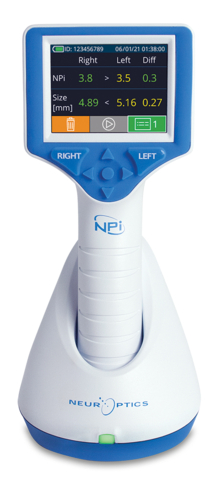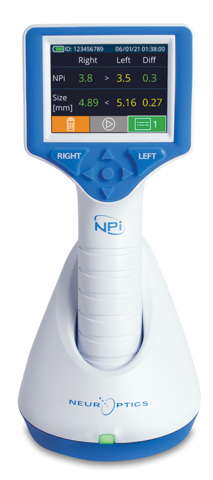IRVINE, Calif.--(BUSINESS WIRE)--A new prospective, multicenter study, recently published in The Lancet Neurology has revealed the significant prognostic value of the Neurological Pupil index™ (NPi®), measured using the NeurOptics NPi Pupillometer, in evaluating disease progression and predicting outcomes for patients with acute brain injury.
This international study, coordinated by the Milano Bicocca University, enrolled 514 patients diagnosed with traumatic brain injury (TBI), aneurysmal subarachnoid hemorrhage (aSAH), or intracerebral hemorrhage (ICH), admitted to the intensive care units of 13 hospitals across Belgium, France, Germany, Norway, Switzerland, Spain, Italy, and the USA. The primary aim of the study was to investigate the association between NPi and 6-month neurological outcomes and mortality. Patients' NPi scores were measured using NeurOptics' NPi Pupillometer every four hours during the initial seven days of admission.
Results demonstrated the clinical and statistical significance of NPi, providing insights into neurological outcomes and 6-month mortality rates. These findings mark a significant step forward in standardizing the use of the NPi Pupillometer.
“Our findings support the use of NPi as a standardized, quantitative measurement of pupil reactivity and global midbrain function,” said Guiseppe Citerio, MD, Principal Investigator and Professor of Anesthesia and Intensive Care at Milano Bicocca University, emphasizing the integral role of NPi evaluation in the clinical assessment of brain-injured patients. "Tracking a patient's NPi score dynamically predicts their neurological outcome and mortality over a 6-month period. Reduced NPi scores are a serious alarm and are associated with unfavorable outcomes. Conversely, when the NPi reduction returns to the normal range, the risk of poor outcomes diminishes. NPi plays a crucial role in dynamically monitoring the progression of acute brain injuries."
The NeurOptics NPi Pupillometer has emerged as a crucial technology, providing a quantitative measurement of pupil size and reactivity, denoted by the Neurological Pupil Index (NPi). NPi values range from 0 to 4.9, with scores below 3 indicating abnormalities. The NeurOptics NPi Pupillometer minimizes the subjectivity inherent in manual pupillary evaluations, offering a more precise, reliable, and objective measurement of pupil size and reactivity, essential components of neurological examinations. The presence of an abnormal NPi value holds significant implications for clinicians managing critically ill patients with brain injuries or those at risk of secondary neurological damage.
NeurOptics’ quantitative automated NPi Pupillometer provides a reliable measurement of pupil size and reactivity and tracks changes over time, allowing for earlier intervention for patients with brain injury and those at risk of secondary neurological injury. The NPi Pupillometer supports neurological examination in adult and pediatric patients across a broad spectrum of diagnoses, including traumatic brain injury, stroke, seizure, or other neurological events after cardiac arrest and other medical conditions.
The study, titled "The Neurological Pupil Index for Outcome Prognostication in People with Acute Brain Injury (ORANGE): A Prospective, Observational, Multicenter Cohort Study," is accessible here.
About NeurOptics
Headquartered in Irvine, Calif., NeurOptics is the worldwide leader in pupillometry. Driven by a passion to help clinicians improve patient outcomes, NeurOptics develops and markets innovative technology for critical care medicine, neurology, neurosurgery, emergency medicine, and research. The NeurOptics’ NPi Pupillometer has been included in more than 120 clinical studies, adopted in over 650 hospitals in the U.S., and is represented in more than 35 countries worldwide. For more information, visit www.NeurOptics.com. Follow NeurOptics on Facebook, LinkedIn, and X (formerly Twitter).
NeurOptics, the NeurOptics logo, Neurological Pupil index, NPi, SmartGuard, and NPi-Connect are trademarks or registered trademarks of NeurOptics, Inc. in the U.S.
©2023 NeurOptics. All rights reserved.
References:
- Kim TJ, Ko SB. Implication of Neurological Pupil Index for monitoring of brain edema. Acute Crit Care. Feb 2018;33(1):57-60. doi:10.4266/acc.2017.00213.
- Oddo M, Sandroni C, Citerio G, et al. Quantitative versus standard pupillary light reflex for early prognostication in comatose cardiac arrest patients: An international prospective multicenter double-blinded study. Intensive Care Med. Dec 2018;44(12):2102-2111. doi:10.1007/s00134-018-5448-6.
- Olson DM, Stutzman S, Saju C, Wilson M, Zhao W, Aiyagari V. Interrater reliability of pupillary assessments. Neurocrit Care. Apr 2016;24(2):251-7. doi:10.1007/s12028-015-0182-1.
- Privitera CM, Neerukonda SV, Aiyagari V, et al. A differential of the left eye and right eye neurological pupil index is associated with discharge modified Rankin scores in neurologically injured patients. BMC Neurol. Jul 2022;22(1):273. doi:10.1186/s12883-022-02801-3.




